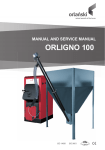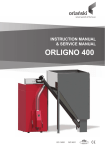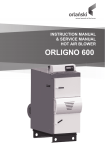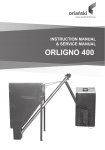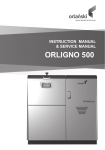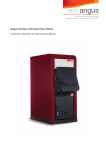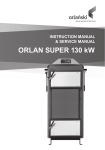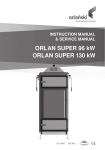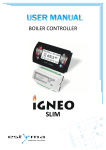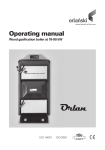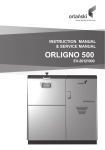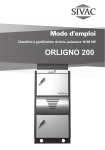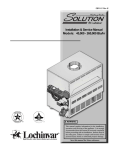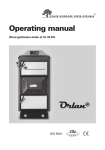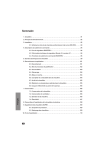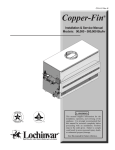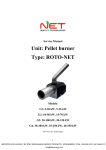Download ORLIGNO 100
Transcript
MANUAL AND SERVICE MANUAL ORLIGNO 100 Content 1. Boiler application . . . . . . . . . . . . . . . . . . . . . . . . . . . . . . . . . . . . . . . . . . . . . . . . . . . . . . . . . . . . . . . . 3 2. Installation . . . . . . . . . . . . . . . . . . . . . . . . . . . . . . . . . . . . . . . . . . . . . . . . . . . . . . . . . . . . . . . . . . . . . . 4 2.1. Ventilation . . . . . . . . . . . . . . . . . . . . . . . . . . . . . . . . . . . . . . . . . . . . . . . . . . . . . . . . . . . . 4 2.2. Supply-air ventilation . . . . . . . . . . . . . . . . . . . . . . . . . . . . . . . . . . . . . . . . . . . . . . . . . . 4 2.3. Exhaust ventilation . . . . . . . . . . . . . . . . . . . . . . . . . . . . . . . . . . . . . . . . . . . . . . . . . . . . 4 2.4. Chimney connection . . . . . . . . . . . . . . . . . . . . . . . . . . . . . . . . . . . . . . . . . . . . . . . . . . . 4 3. Technical data . . . . . . . . . . . . . . . . . . . . . . . . . . . . . . . . . . . . . . . . . . . . . . . . . . . . . . . . . . . . . . . . . . . 5 3.1. Dimensions . . . . . . . . . . . . . . . . . . . . . . . . . . . . . . . . . . . . . . . . . . . . . . . . . . . . . . . . . . . 6 3.2. Boiler construction . . . . . . . . . . . . . . . . . . . . . . . . . . . . . . . . . . . . . . . . . . . . . . . . . . . . 6 3.3. Safety valve connection . . . . . . . . . . . . . . . . . . . . . . . . . . . . . . . . . . . . . . . . . . . . . . . . 7 4. Boiler startup . . . . . . . . . . . . . . . . . . . . . . . . . . . . . . . . . . . . . . . . . . . . . . . . . . . . . . . . . . . . . . . . . . . 9 4.1. Boiler stoking . . . . . . . . . . . . . . . . . . . . . . . . . . . . . . . . . . . . . . . . . . . . . . . . . . . . . . . . 10 4.2. Tarring and condensation . . . . . . . . . . . . . . . . . . . . . . . . . . . . . . . . . . . . . . . . . . . . . 10 5. Maintenance . . . . . . . . . . . . . . . . . . . . . . . . . . . . . . . . . . . . . . . . . . . . . . . . . . . . . . . . . . . . . . . . . . . . 11 2 1. Boiler application Steel boiler ORLIGNO 100 tested according to EN 303-5 is designed for central heating installations with maximal temperature on the boiler 90ºC and working pressure 3 bar. Recommended fuel for boiler: wood, coke, coal and in case of mounting pellet burner – pellets and oats. TTENTION! A Using fuel different than the recommended not guarantees optimum boiler operation and achieving parameters featured in technical data. It can also affect durability of the boiler and its components. TTENTION! A Using fuel different than the recommended is treated as wrong boiler operation and resultant performance irregularities cannot be reason for complaint. 3 2. Installation 2.1. Boiler-room ventilation According to european safety regulations each boiler room should have supply-exhaust ventilation ensuring correct boiler operation and user’s safety . Lack of ventilation or its obstruction is the main reason of incorrect boiler operation (i.e. boiler cannot reach set temperature).Exhaust ventilation removes from boiler room used air and harmful gases. Boiler room with natural draught cannot have installed mechanical ventilation. 2.2. Supply air ventilation 1. Ventilating duct section should have at least 50% area of chimney’s section and not less than 20 x 20 cm. Duct should be placed 1m above the floor. 2. Ventilating duct should have installed device for air flow control; device shouldn’t limit duct section above 1/5.Ventilating duct should be made of non-inflammable material. 2.3. Exhaust ventilation 1. Exhaust duct should be made of bricks with section of at least 25% of chimney section not less 14 x 14 cm. Inlet hole cannot have any devices that reduce its section. Outlet hole should be placed close to the ceiling led out 1,5 m above the roof. Ventilating duct should be made of non-inflammable material. 2. Height of the boiler room min. 2,2 m. 2.4. Chimmey connection. Chimney ducts should be installed according to binding rules and norms in countries to which boilers are sold. Part of chimney system connection boiler with chimney is called flue. In order to lower flow resistance of exhaust gases this part should lead as a straight pipe with, if necessary, joints up to 45°. Because of exhaust gases temperature ORLIGNO 100’s need to be connected to heat-resistant. 30 cm above the floor closing door should be installed with tight closing. Chimney section should be round or close to square shape because of low flow resistance. Minimal flue diameter should be 160 mm. Chimney should lead above the roof. Chimney outlet location is dependent on roof slope and its combustibility. 4 3. ORLIGNO 100 – technical data Power wood Coke/pellets kW kW Boiler class acc. to EN-303-5 14 30/16 3 % 76,5 86 Max working pressure bar 3 90 Efficiency coke pellets Max temperature °C Min. temperature °C 60 Water capacity ltr. 60 Weight kg 305 Loading chamber capacity ltr. 70 1100 Length mm Width mm 675 Height mm 1220 mm 300x300 Water outlet Upper door dimensions inner thread inch 5/4” Return inner thread inch 5/4” Drain valve inner thread inch ½” Cooling coil inner thread inch ½” Min. cooling coil pressure bar 2 Flue diameter mm 160 Required chimney draft Pa 20 % 23/12 Exhaust gases temperature at nominal power °C 250-280 coke h 4,5 wood h 2-2,5 mm 500 6-8 Max. moisture content: Burning period at nominal power Fuel parameters Water resistance wood/pellets wood/max length pellets/ diameter mm ∆t=20 K mbar 0,8 ∆t=10 K mbar 3,4 5 3.1. Dimensions 3.2. Boiler construction 6 3.3. Safety valve connection 7 ORLIGNO 100 is equipped with copper cooling coil mounted in boiler body, protecting boiler from overheating. To one of cooling coil tappings on right side of the boiler one should connect safety valve. When temperature increases above 95ºC safety valve opens and lets in cold water through cooling coil. Water from mains at 10ºC temperature cools down boiler, water from boiler is removed to drain. 8 4. Boiler startup Before first startup it is necessary to: -Check water level in installation, pressure in installation should be 2 bar. -Check fire-grate location (fire-grate gaps from bottom should be bigger than from top). -Draft regulator seal with oakum and mount, fit arm and block with screw. Startup: -Mount draft regulator horizontally, regulator set on 70°C. -Open flue flap. -Put on fire-grate papers and small wood pieces; open bottom door . -After lightning up put bigger wood logs and create ember layer (close bottom door and unscrew primary air flap – opening in flap at least 2cm- regulation knob is located on bottom door. -After creating ember layer fully load boiler with wood or coke. Put wood logs along chamber. -Set chimney draft with flue flap -Connect draft regulator chain with primary air flap. Burn in boiler up to 70°C then set draft regulator on 70°C and shorten chain till primary air flap is barely opened. Draft regulator knob is for temperature change. Marking on regulator is every 10°C. TTENTION! A Before stoking boiler open slowly open upper door to suck out gases. TTENTION! A It is not allowed to open bottom door during boiler burning – glow may fall out. SECONDARY AIR SETTINGS: -wood opening ½ -coke opening ¼ . Troubleshooting Reason Activity Heat exchanger gets dirty to fast Use good quality wood, moisture content 18-23%. Smoke leakage Seal chimney pipe, open more flue flap, check chimney draft Too high temperature of exhaust gases Check fuel moisture content, cannot be too dry. Check secondary air settings. Too short burning period To high exhaust gases temperature: burning period depends on used fuel and heat demand 9 4.1. Boiler stoking In order to stoke boiler: 1. Close primary air flap. 2. Open completely flue flap. 3. Open slightly upper door in order to suck out gases through chimney. 4. Open completely upper door and stoke boiler. 5. Close upper door, return to previous setting of flue flap and primary air. 4.2. Tarring and condensation Lightning up in cold boiler may cause that water precipitated from fuel falls on boiler walls and runs down to ash chamber. That may look like boiler leakage. It is important to keep boiler temperature high enough at least 70°C. It is recommended to install four-way mixing valve which protects boiler from low temperature return below 50°C. Too humid wood also causes that boiler works on low temperatures, which leads to tarring. In order to avoid problem of tarring and condensation – keep high boiler temperatures, boiler must be properly sized to heated space to avoid oversizing – boiler then will work on low temperatures. 1. Boiler ORLIGNO 100 2. Pressure vessel 3. Radiator 4. Safety valve- protection- from verheating 5. Four-way mixing valve 6. Safety group 10 5. Maintenance dvice: A Clean boiler works efficiently. Boiler life is extended. -Fire-grate and ash clean/remove daily. -Boiler must be cool during this activities. -Open upper door and remove cleaning flap. -Check if heat exchanger surfaces are cleaned, clean with brush. -Remove ash from bottom chamber ( ashpan may be hot). -Fit cleaning flap. -Each 2-4 weeks clean boiler depending on burning intensity. 11 12 INSTRUCTION MANUAL Contents 1. Basic informations . . . . . . . . . . . . . . . . . . . . . . . . . . . . . . . . . . . . . . . . . . . . . . . . . . . . . . . . . . . . . . 14 1.1. Construction description and burner application . . . . . . . . . . . . . . . . . . . . . . . . . . 14 1.2. Fuel characteristics . . . . . . . . . . . . . . . . . . . . . . . . . . . . . . . . . . . . . . . . . . . . . . . . . . . 15 1.3. Transport and delivery specification . . . . . . . . . . . . . . . . . . . . . . . . . . . . . . . . . . . . 16 2. Burner’s technical data . . . . . . . . . . . . . . . . . . . . . . . . . . . . . . . . . . . . . . . . . . . . . . . . . . . . . . . . . . 17 3. Package . . . . . . . . . . . . . . . . . . . . . . . . . . . . . . . . . . . . . . . . . . . . . . . . . . . . . . . . . . . . . . . . . . . . . . . 18 4. Location and package installation . . . . . . . . . . . . . . . . . . . . . . . . . . . . . . . . . . . . . . . . . . . . . . . . . 19 4.1. Rules, norms, recommendations . . . . . . . . . . . . . . . . . . . . . . . . . . . . . . . . . . . . . . . 19 4.2. Boiler room recommendation . . . . . . . . . . . . . . . . . . . . . . . . . . . . . . . . . . . . . . . . . 20 4.3. Ventilation . . . . . . . . . . . . . . . . . . . . . . . . . . . . . . . . . . . . . . . . . . . . . . . . . . . . . . . . . . . 20 4.4. Safe distance to inflammable substances . . . . . . . . . . . . . . . . . . . . . . . . . . . . . . . 20 5. Putting into operation . . . . . . . . . . . . . . . . . . . . . . . . . . . . . . . . . . . . . . . . . . . . . . . . . . . . . . . . . . . 22 5.1. Burner start . . . . . . . . . . . . . . . . . . . . . . . . . . . . . . . . . . . . . . . . . . . . . . . . . . . . . . . . . . 22 5.2. Burner’s assembly to ORLIGNO 100 . . . . . . . . . . . . . . . . . . . . . . . . . . . . . . . . . . . . 22 5.3. Adjustment of ORLIGNO 100 to work with pellet burner . . . . . . . . . . . . . . . . . . . 22 5.4. Tank assembly . . . . . . . . . . . . . . . . . . . . . . . . . . . . . . . . . . . . . . . . . . . . . . . . . . . . . . . 24 5.5. Before starting of the burner it is necessary . . . . . . . . . . . . . . . . . . . . . . . . . . . . . . 25 6. Burner’s maintenance . . . . . . . . . . . . . . . . . . . . . . . . . . . . . . . . . . . . . . . . . . . . . . . . . . . . . . . . . . . 26 7. Troubleshooting . . . . . . . . . . . . . . . . . . . . . . . . . . . . . . . . . . . . . . . . . . . . . . . . . . . . . . . . . . . . . . . . 27 II. Instrukcja regulatora . . . . . . . . . . . . . . . . . . . . . . . . . . . . . . . . . . . . . . . . . . . . . . . . . . . . . . . . . . . . . 28 8. Main functions of the controller. . . . . . . . . . . . . . . . . . . . . . . . . . . . . . . . . . . . . . . . . . . . . . . . . . . 28 9. Graphic display . . . . . . . . . . . . . . . . . . . . . . . . . . . . . . . . . . . . . . . . . . . . . . . . . . . . . . . . . . . . . . . . 29 10. Service. . . . . . . . . . . . . . . . . . . . . . . . . . . . . . . . . . . . . . . . . . . . . . . . . . . . . . . . . . . . . . . . . . . . . . . . 30 11. Simple menu . . . . . . . . . . . . . . . . . . . . . . . . . . . . . . . . . . . . . . . . . . . . . . . . . . . . . . . . . . . . . . . . . . 33 12. Main menu . . . . . . . . . . . . . . . . . . . . . . . . . . . . . . . . . . . . . . . . . . . . . . . . . . . . . . . . . . . . . . . . . . . . 35 13. Heating . . . . . . . . . . . . . . . . . . . . . . . . . . . . . . . . . . . . . . . . . . . . . . . . . . . . . . . . . . . . . . . . . . . . . . . 36 14. Hot domestic water . . . . . . . . . . . . . . . . . . . . . . . . . . . . . . . . . . . . . . . . . . . . . . . . . . . . . . . . . . . . . 38 15. Water tank . . . . . . . . . . . . . . . . . . . . . . . . . . . . . . . . . . . . . . . . . . . . . . . . . . . . . . . . . . . . . . . . . . . . . 40 16. Boiler. . . . . . . . . . . . . . . . . . . . . . . . . . . . . . . . . . . . . . . . . . . . . . . . . . . . . . . . . . . . . . . . . . . . . . . . . . 40 17. Settings . . . . . . . . . . . . . . . . . . . . . . . . . . . . . . . . . . . . . . . . . . . . . . . . . . . . . . . . . . . . . . . . . . . . . . . 41 18. Burner . . . . . . . . . . . . . . . . . . . . . . . . . . . . . . . . . . . . . . . . . . . . . . . . . . . . . . . . . . . . . . . . . . . . . . . . . 41 19. Alarms . . . . . . . . . . . . . . . . . . . . . . . . . . . . . . . . . . . . . . . . . . . . . . . . . . . . . . . . . . . . . . . . . . . . . . . . 43 20 Electric installation . . . . . . . . . . . . . . . . . . . . . . . . . . . . . . . . . . . . . . . . . . . . . . . . . . . . . . . . . . . . . . 44 13 1. Basic informations 1.1. Construction description and burner application Self- cleaning burner is a new look into the automatic burning of solid fuels in Europe – pellets of 6-8 mm of diameter or as a option oats with maintaining low emissions, complying with European norms. Burner doesn’t have any drawbacks of chute burners –gravitational, in which ash and sinter have to be removed manually. Main burner advantage is its simple service: just fill in hopper with pellets and press START button. Reports are shown on big graphic display. Within few minutes burner will automatically select work parameters, maintain constant room temperature and hot utility water. Burner’s features: -automatic burner’s start -automatic modulation -flame control through photo-cell -low heat inertness during start and stop -low electric energy consumption -possibility to control 16 heating circuits (radiators and underfloor heating or hot utility water) – option -control of burner’s temperature -three phases of lightning up eliminate risk of explosions -AUTOSTART function after power failure – memory of last settings -separation of primary and secondary air – emissions on the same level as in gas and oil burners -efficiency > 94,5% -soot = 0 -self-cleaning function, automatically removes ash from the burner’s grate -oats –burner’s construction enables to burn grain (oats) – option 2 years of warranty for appliance durability enables to decrease exploitation and service costs. Burner’s regulator can control: - boiler pump -1-16 heating circuits (radiators or underfloor heating) controlled according to outside temperature -room’s temperature 14 Useful functions of controller: You don’t have to keep in mind about next boiler service – it is shown on the display Statistics – function enables to preview -minimal, maximal and average burner’s power -fuel usage: minimal, maximal and average. Temperature’s parameters are shown as a digits and charts on big graphic display 1.2. Fuel characteristics a) Pellet granulate made according to DIN 51731 -granulate 5-8 mm -recommended calorific value 17500-19500 kJ/kg -ash content 1,5% -max moisture content 12% -density 1-1,4 kg/dm³ b) Oats - moisture content <15% TTENTION! A It is recommended to use fuel from reliable sources. Fuel should have appropriate humidity and low content of small fractions. It is necessary pay attention especially to mechanical pollution ( stones), which worsen burning process and may lead to burner’s failure. Eko-Vimar Orlański sp. z.o.o. is not responsible for appliance failure or improper burning process when using inappropriate fuel. 15 1.3. Transport and delivery specification Burner during transport should be secured with straps against leaning and movement. Burner need to be stored in roofed and dry place. Burner is delivered in separate boxes wrapped in foil. Boxes contains: pellet tank with lid, fuel feeder, burner with controller and elastic feeding pipe. Before installation it is recommended to check delivery completeness and its condition. 16 2. Burner’s technical data Parameter Pellet power range Oats power range* Efficiency CO emission Weight Feeder length standard Feeder length option Fuel Fuel diameter Fuel (option) humidity<15% Voltage Power consumption Protection level Tank dimensions Capacity SI kW kW % ppm kg m m mm V W mm L 16 kW 4 – 16 3,6 – 14,4 >94,5 <200 14 1,3 – 1,6 2.0;2.5;3.0 pelety 6–8 owies 230 30 IP40 600x600x1400 305 TTENTION! A Producer reserves the right for construction and documentation changes in order to modernize the boiler. 1. Boiler 2. Burner 3. Fuel tank 4. Feed system Pic.1. Basic package elements. 17 1. Burner’s body 2. Grate 3. Fan 4. Feeder casing ( worm+ igniter) 5. Drive plate 6. Plate for electric connections 7. Sealant 8. Motoreducer 9. Burner’s casing Pic.2. Burner construction 3. Package Standard package: 18 -burner -controller -fuel feeder -tank -manual -4 refractory bricks -Sensor sleeve ½” 4. Location and package installation 4.1. Rules, norms, recommendations Boiler room should comply with construction law valid in country where boiler is installed. Pic.3. Package layout. 19 4.2. Boiler room recommendation -Package ( boiler, burner, tank, feeder) should be placed in separate room, centrally to heated rooms -Front door should open outside and must be made of nonflammable materials, with 0,8 width -Floor should be made of nonflammable materials or covered with 0,7 mm steel plate at minimum 0,5 m distance to door edges. Boiler should be located on a nonflammable foundation, lifted 0,05 m above floor level -Boiler room should have artificial lightning but natural light is also recommended -Distance to walls in boiler room should allow for easy access to all sides of the boiler -Minimal distance from front side of the boiler to opposite wall should be 1m -Minimal height of the boiler room: at least 2,2 m; in existing building it is allowed 1,9 m with assured supply-exhaust ventilation. -It is forbidden to install boiler and burner in damp rooms or with elevated humidity. Corrosion process may in short time damage the boiler and burner. 4.3. Ventilation -Boiler room should have 200 cm² supply-air duct -Exhaust duct should have at least 14x14 cm section with inlet hole under boiler room ceiling that should lead above roof and be placed near chimney. -Ventilation ducts should be made of nonflammable materials. -It is forbidden to install mechanical ventilation TTENTION! A High risk of carbon monoxide poisoning exists if boiler is located in a room with insufficient access to fresh air. 4.4. Safe distance to inflammable substances -During installation and exploitation it is advisable to maintain safe distance of 200 mm from inflammable substances -For inflammable substances with C3 grade of combustibility which rapidly and easy burn (ex. paper, cardboard, wood, plastic) distance is minimum 400 mm; -If combustibility grade is unknown safe distance should be doubled. 20 Combustibility grade of building products Building products A – non-burning sandstone, concrete, bricks, fire plaster, Mortar, tile, granite B - hard burning cement board, fiberglass, mineral insulation C1- hard burning beech tree, oak tree, plywood C2 – middle burning pine, larch, spruce tree, cork, rubber floor cover C3 – easy burning tarmac plywood, celuloids, polyurethane, Polystyrene, polyethylene, plastic User please remember: -Only adult person acquainted with this manual may operate the burner It is forbidden for kids to stay in close distance to burner without presence of adult person. -If inflammable gases penetrate boiler room during activities (varnishing, gluing) it is recommended to turn off the burner. -It is forbidden to use inflammable substances for lightning up the burner, burner will light up automatically. -High risk of fire exist when using open fire or inflammable substances close to installed boiler package. -Burner should be turned off during maintenance (position OFF. -Pay attention on hot burner’s surfaces – risk of burn. -It is forbidden to lay inflammable items on the burner or nearby. -All defects should be removed at once. -After heating season it is recommended to clean the burner and pellet tank thoroughly. -Oversee the burner during power failure -It is forbidden to manipulate with any electric parts or interfere in burner’s construction. 21 5. Putting into operation 5.1. Burner start First startup of the burner must be done by authorized company trained by manufacturer with valid certificate of authorized serviceman issued by Eko-Vimar Orlanski ltd. 5.2. Burner’s assembly to ORLIGNO 100 1. Remove the screws (1) fastened to burner’s casing (pic.4) and take off casing (2) 2. T ake off ORLIGNO 100 bottom door 3. Fix adapter (3) in bottom’s door place (pic.5) 4. F ix burner (4) in adapter (3) screwing it with two bolts (5) 5. Mount burner’s casing (2) with two screws (1) 6. S lide feeder’s pipe (6) in to fixing pipe (7) (pic.6) 7. Fit flexible pipe (8) on feeder’s pipe (6) and secure with band clip (9) 8. Fit flexible pipe (8) on burner’s pipe (10) and secure with band clip (9) 5.3. Adjustment of ORLIGNO 100 to work with pellet burner 1. Remove iron-cast grate from boiler. 2. P lace two refractory bricks on each of two supports above support for iron-cast grate. Pic.4. Disassembly of burner’s casing. 22 Pic.5. Burner assembly. Pic.6. Feeder assembly 23 5.4. Tank assembly 24 5.5. Before starting of the burner it is necessary: 1. Check installation condition. 2. F ill in pellet to the tank, cover with lid 3. Check if fuel contains any unwanted elements ( rocks, metal elements) 4. S crew in sensor’s sleeve in one of two probes on the right side of boiler behind safety coil 5. Put the boiler sensor in to the sleeve Pellet* 30% of power 100% of power Feed time 1,5 5 Max air 8 13 OATS** Feed time 2 7 Max air 9 14 8. Feed fuel from tank till it show up in flexible pipe. 9. T urn off fuel feed and hold ON button. 10. W hen changing fuel ex. on oats; it is necessary: -turn off boiler -wait till boiler cool down -remove pellet grate and clean surface -put oats grate -set feed time and max air amount acc. to chart 11. B urner maintenance after heating season: -turn off and disconnect from power supply -clean thoroughly -remove pellet from tank 25 6. Burner’s maintenance TTENTION! A It is necessary to put out, cool down and disconnect burner from power supply when servicing. Pay attention on hot burner’s surfaces – risk of burn. In order to keep high efficiency of burner it is recommended to clean and service it systematically. Remove soot and ash from burner’s grate. TTENTION! A Much more ash is created during oats burning than pellets. Cleaning activities: 1. Turn off the boiler (wait till burner completely put out), disconnect boiler from power supply and wait till boiler cool down. 2. D isconnect burner form boiler and power supply. 3. Remove grate from burner and clean it ( check permeability of air holes) Clean burner’s casing (pic.7) Pic.7. Burner maintenance. 26 7. Troubleshooting Type of defect Possible cause of defect Suggested repair One of controller’s button doesn’t work Display malfunction Display repair Automatic lightning up Doesn’t work Wrong connection of igniter or photo-cell Check plug and wires connections of igniter and photo-cell Clogged outlet hole of hot air Clean heater hole Very damp fuel Change or dry fuel Damaged igniter Replace igniter Damaged photo-cell Replace photo-cell Smoke from door or burner Water in boiler Boiler cannot reach set temperature Lack of chimney draft Clogged chimney Clogged heat exchanger Clean heat exchanger Damaged sealant (rope) Replace sealant (rope) Lack of chimney draft Improper chimney installation Very damp fuel Change or dry fuel Leaky heat exchanger To check heat exchanger, turn off boiler on 8 hours, remove water, when water is still in boiler – call service Improperly selected boiler for heating space Check if boiler is properly selected Wrongly located sensor of return water Check sensor location Sensor malfunction Check sensors Set low boiler power Check feed time and fan power 27 8. Main functions of the controller. 8.1. Front panel Graphic display (2.1.3) Buttons (2.1.2) Status diode (2.1.1) 8.2. Status diode Lightning description Green- continuous light Green – pulsate Orange – continuous light Orange – pulsate Red – continuous light Red – pulsate 28 Meaning Controller off Controller on, burner off Controller on, burner on Burner work Alarm – to confirm Alarm active 8.3. Buttons Function Button Return, Esc Return in menu to previous level, cancellation of parameter’s change. After pressing button > 3 sec – change of controller’s status ON/OFF Menu moving, decrease parameter’s value On main display entering to simple menu Arrow down Shows navigational informations and description of parameters Info Menu moving, increase parameter’s value On main display entering to simple menu Arrow up Enter the menu. Confirmation of edited parameter Alarm confirmation Enter 9. Graphic display 9.1. Graphic display grate status weekday time set temperature actual temperature object symbol (boiler) processor’s temperature number of unconfirmed alarms heating program ( time program, permanent, off) h.d.w. program (time program, permanent, off) grate program (OFF/ON) controller’s status (OFF/ON) 29 9.2. Grate statuses Status OFF Cleaning Lightning up Kindling Power 1 Power 2 Modulation Extinguishing Stop Description Burner doesn’t work. Work approval off. Burner cleaning with strong stream of air. Fuel lightning up. Initial fuel feeding, Heater and fan are on. After flame detection, additional fuel feeding and fan power increase for better grate kindling. Burner works with first power. Burner works with second power. Burner works with modulated power. Grate extinguishing. Feeder and fan work till flame die out. Burner doesn’t work. Required boiler’s temperature reached. 10. Service 10.1. Menu navigation Controller contains two types of menu: simple and main menu. Simple menu – enables to access basic functions of the controller. To enter simple menu press button “arrow up” or “arrow down” on main display. Simple menu description chapter 4. Main menu – enables to access all functions of the controller ( monitoring of status, changes and service settings ). To enter main menu press “Enter” on main display. Main menu description chapter 5. TTENTION! A Service menu is only for qualified staff. Any settings’ changes may lead to incorrect system operation. 10.2. Start of the controller ON In order to start the controller (mode ON) press for 3 sec “Return, Esc” on main display, when it is in OFF mode. 30 10.3. Shutdown of the controller OFF In order to turn the controller off (mode OFF) press for 3 sec Return, Esc” on main display, when it is in ON mode. ATTENTION! After controller shutdown depending on its previous status, burner may still work (extinguishing ), it’s not advisable to disrupt this process. If controller will be disconnected from main power, please wait till burner status is on OFF mode. 10.4. Time programs Controller is equipped with clock and calendar. Thanks to that it is possible to program work of individual parts of heating system depending on current time and weekday. Date and time aren’t deleted during power outage because controller contains battery, which needs to be replaced every 2 years. Programming takes place in menu of given heating circuit ( ex. hot domestic water, heating, water tank) and for each element proceeds in the same way. Weekday choice. After entering in menu “ Time program”, weekday pulsates, with arrow buttons choose day for setting or just to check program settings. Programming. After choosing weekday and confirming with “Enter” button; current programmed hour starts to pulsate, next to displayed hour, icon with chosen time zone is shown (sun symbol stands for comfort temperature, moon symbol – economic temperature). To move to next hour press “arrow down” button ( comfort temperature) or “arrow up” (economic temperature). If all day is programmed press “enter”. After confirmation of changes (or cancellation) weekday starts to pulsate. grate status day arrow up – set comfort temperature arrow down – set economic temperature chosen temperature (economic) actual set temperature Economic temperature 00:00 - 6:00 Comfort temperature 6:00 - 9:00 Economic temperature 9:00 - 18:00 Comfort temperature 18:00 - 24:00 31 TTENTION! A Values of economic and comfort temperatures are set in SETTINGS menu and may differ for each of the heating circuits. In order to activate time program activate it in SETTINGS menu. 10.5. Service password Access to service parameters is protected with password. After writing correct password access is cleared. Access is denied after 10 minutes without pressing the buttons. Service password: it is a set temperature in BOILER/SETTINGS menu and 3 letters “EST” Example: If set temperature in BOILER/SETTINGS menu is 60°C then password is: „60EST”. TTENTION! A Service menu is only for qualified staff. Any settings’ changes may lead to incorrect system operation. 32 11. Simple menu 11.1. Simple menu’s displays Display Description Shows current boiler temperature (large type) and programmed temperature (small type). After pressing “Enter” button: set desired boiler’s temperature Shows current h.d.w. temperature (large type) and programmed temperature (small type). After pressing “Enter” button: set desired h.d.w. temperature Heats once h.d.w. till reaching comfort temperature no matter of program. H.d.w. program no. 1: a. time program – according to programmed time- intervals b. permanent – no matter of time-intervals comfort temperature is kept c. off – heating is turned off. 33 Shows current room temperature in room no.1 (large type) and set value (small type). After pressing “Enter”, set desired room temperature Circuit heating program no. 1: a. time program – according to programmed time- intervals b. permanent – no matter of time-intervals comfort temperature is kept c. off – heating is turned off Burner work: ON/OFF. When burner is OFF, controller controls heating system, but doesn’t start the burner. Manual start of feeder from pellet tank. Function useful after fuel runs out. After filling the tank with fuel activate FEED THE FUEL function, till the moment when fuel will be on the burner. 34 12. Main menu 13 Heating strona 36 14 H.d.w page 38 15 Water tank page 40 16 Boiler page 40 17 Settings page 41 18 Burner page 41 19 Alarms page 43 35 13. Heating 13.1. Circuit selection Enables to choose number of heating system circuit. Selection of circuit: “arrow down/up”. 13.2. Status Enables to monitor status of central heating. Circuit number Name of circuit Measured temperature/ programmed in room Measured temperature/ programmed in radiators Outside measured temperature Valve work time (sec) Programmed temperature at source (°C) Valve work signalling Pump work signalling 36 13.3. Settings Description of functions in submenu SETTINGS. Function Comfort temperature Program Economic temperature Description Programmed temperature in room during heating. Programs: a. time program – according to programmed time- intervals b. permanent – no matter of time-intervals comfort temperature is kept c. off – heating is turned off d. e conomic – during all period economic temperature in room is kept Programmed temperature in room after heating period 13.4. Time program It is for time program configuration that controls central heating. Settings description of time program can be found in chapter 3.4 13.5. Service TTENTION! A Service menu is only for qualified staff. Any settings’ changes may lead to incorrect system operation. Description of functions in submenu SERVICE. Function Temp. MIN pump comf. Temp. MIN pump. econ. Description Minimal calculated central heating temperature, at which pump is ON during comfort period. Minimal calculated central heating temperature, at which pump is on during economic period Source Max. temperature Determines source of energy for central heating Maximal calculated temperature for central heating Mixing valve time H.d.w. priority Pump test Time when mixing valve is fully opened H.d.w. priority for given central heating circuit; during h.d.w. heating, central heating pump doesn’t work Starts circulation pump regardless of outside conditions. Mixing valve test Circuit name Starts mixing valve actuator regardless of outside conditions. Gives the name for central heating circuit. 37 14. Hot domestic water 14.1. Circuit selection Enables to choose number for h.d.w. circuit. 14.2. Status Enables to monitor status of h.d.w. Circuit number Circuit name Measured temperature/ programmed for h.d.w. Source programmed temperature (°C) Pump work signalling 38 14.3. Settings Description of functions in submenu SETTINGS Function Comfort temperature Program Heat now Description Programmed temperature of h.d.w. during heating period Programs: a. time program – according to programmed time- intervals b. permanent – no matter of time-intervals comfort temperature is kept c. off – heating is turned off Hysteresis Heats once h.d.w. up to comfort temperature regardless of program Decrease of temperature value for h.d.w. Economic temperature Programmed h.d.w. temperature after heating period. 14.4. Time program It is for time program configuration of h.d.w. Settings description of time program can be found in chapter 3.4 14.5. Service TTENTION! A Service menu is only for qualified staff. Any settings’ changes may lead to incorrect system operation. Description of functions in submenu SERVICE: Function Source delta Source Max. temperature Delta MIN temp. Description Source temperature increase in relation to programmed h.d.w temperature during heating. Determines source of energy for h.d.w. Pump test Maximal h.d.w. temperature Minimal temperature difference between source and h.d.w, at which pumps work Starts pump regardless of other conditions. Circuit name Gives the name for h.d.w. circuit 39 15. Water tank 15.1. Service ATTENTION! Service menu is only for qualified staff. Any settings’ changes may lead to incorrect system operation. 16. Boiler 16.1. Status Boiler work statistics during last 24h. Chart shows boiler’s temperature and burner power. 16.2. Settings Description of functions in submenu SETTINGS. Function Programmed boiler’s temperature Description Heat medium temperature in the boiler kept by the controller. 16.3. Service ATTENTION! Service menu is only for qualified staff. Any settings’ changes may lead to incorrect system operation. 40 Description of functions in submenu SERVICE: Function Pumps MIN temp Work mode Hysteresis Description Temperature above which controller may turn on the pumps Boiler’s work mode: a. auto – temperature set automatically b. continuous – temperature is kept continuously Temperature’s value that needs to decrease to start the burner. 17. Settings 17.1. Date and time Enables to set the date and controller’s time. 17.2. Language Enables to choose controller’s language in menu. 17.3. Restore factory settings Selecting this option enables to cancel all current controller’s settings and restore factory settings. 18. Burner 18.1. Status Animation showing work of burner’s appliances. 41 18.2. Settings Description of functions in submenu SETTINGS. Function Description Feed the fuel Starts feeder regardless of other functions. Burner’s work Burner’s work approval. Type of fuel Determines type of burned fuel. 18.3. Service TTENTION! A Service menu is only for qualified staff. Any settings’ changes may lead to incorrect system operation. Function Description of functions in submenu SERVICE Air MIN Minimal air amount during modulation or at power no. 1 Air MAX Maximal air amount during modulation or at power no. 2 Feeding MAX MIN power Minimal burner’s power during modulation. Maximal burner’s power during modulation. MAX power Maximal burner power during modulation. Modulation type Test of igniter Method of burner’s work, modulated power or 2 levels of power Brightness in burner, above which controller recognizes flame Starts igniter for test. Test of burner’s feeder Starts feeder for test. Test of fuel’s feeder Test of fan Starts feeder for test. Starts fan for test. Photo threshold 42 19. Alarms Menu contains history of maximum 20 alarms, that occured during controller’s work. Meanings of code alarms is shown below: Alarm codes and their meaning. Code Short description Description 1 Processor’s overheating Controller’s processor has been overheated. Improper controller placement may be one of the reasons. Controller detected lack of flame in burner. Lack of fuel or flame gone out may be one of the reasons. Burner’s temperature has exceeded maximum value 2 Lack of flame/fuel 3 Burner’s overheating 4 Boiler’s sensor short circuit 5 Boiler’s sensor break 6 Burner’s sensor short circuit 7 Gape of burner’s sensor 8 Boiler’s overheating Controller detected short circuit. Damaged sensor or connecting wire may be one of the reasons. Controller detected gape of boiler sensor. Damaged sensor or conecting wire may be one of the reasons. Controller detected gape of sensor. Damaged sensor or connecting wire may be one of the reasons. Controller detected gape of sensor. Damaged sensor or connecting wire may be one of the reasons Boiler’s temperature has exceeded maximum value 9 Processor reset Possible controller’s damage! Lack of power supply 43 20. Electric installation 20.1. Overall requirements Before use of this controller; it is necessary to thoroughly read instruction manual. Person responsible for controller’s installation should have technical experience. Connections made of copper should be adjusted to operate at temperatures of 75°C. All electric connections should comply with electric scheme enclosed in this manual and national or local rules concerning electric installations TTENTION! A Appliance should be connected to separate electric circuit equipped with properly selected RCD (residual current device) and MCB ( miniature circuit breaker). 20.2. Location Appliance is intended for use in confined premises. Assembly location must be free from dampness and inflammable, fumes that cause corrosion. Appliance assembly cannot be done close to any high-power, appliances, industrial equipment or welding equipment. Ambient temperature around assembly place cannot exceed 60°C and should not be lower than 0°C. Humidity should be in range 5-95%. 20.3. Connection It is necessary to connect to boiler sensor and other executiue elements if needed. Picture shows connection diagram of appliances table shows description of inputs and outputs. TTENTION! A It is not allowed to connect (PE) safety wire with zero(N). 44 TTENTION! A Connection works should be made when controller is disconnected from power. Only authorized person is allowed to do electrical connections with necessary qualifications. BACK VIEW OF CONTROLLER FILTER Output description Foto Tkotła Tpalnik Tc.w.u. Tpokój GND Pcwu Zapalarka Pco Dmuchawa Pod.zas. Pod.pal N N1 PE Description Brightness sensor in burner Boiler sensor Burner sensor Hot domestic water sensor Room sensor Ground for sensor connection Hot domestic water pump Burner's igniter Central heating pump Burner's fan Pellet tank feeder Burner's feeder Neutral constant Neutral separable Protective 45 20.4. Technical data PARAMETER Power supply Power consumpion Outputs capacity: Central heating pump Hot domestic water pump Igniter Fan Burner's feeder Pellet tank feeder Measurement accuracy Sensors Outside temperature Humidity Software class 46 VALUE ~230V/50Hz ±10% <6VA 100W 100W 400W 150W 150W 150W ±4ºC NTC 10kΩ B =3877K±0,75% 25/85 VISHAY BCcomponents 0-60ºC 5-95% without condensation A 47 EKO-VIMAR ORLAŃSKI Sp. z o.o. 48-385 Otmuchów, ul. Nyska 17b POLSKA / woj. opolskie T +48 77 400 55 80-81, 400 55 91 F +48 77 439 05 03, 400 55 96 E [email protected] www.orlanski.pl
















































